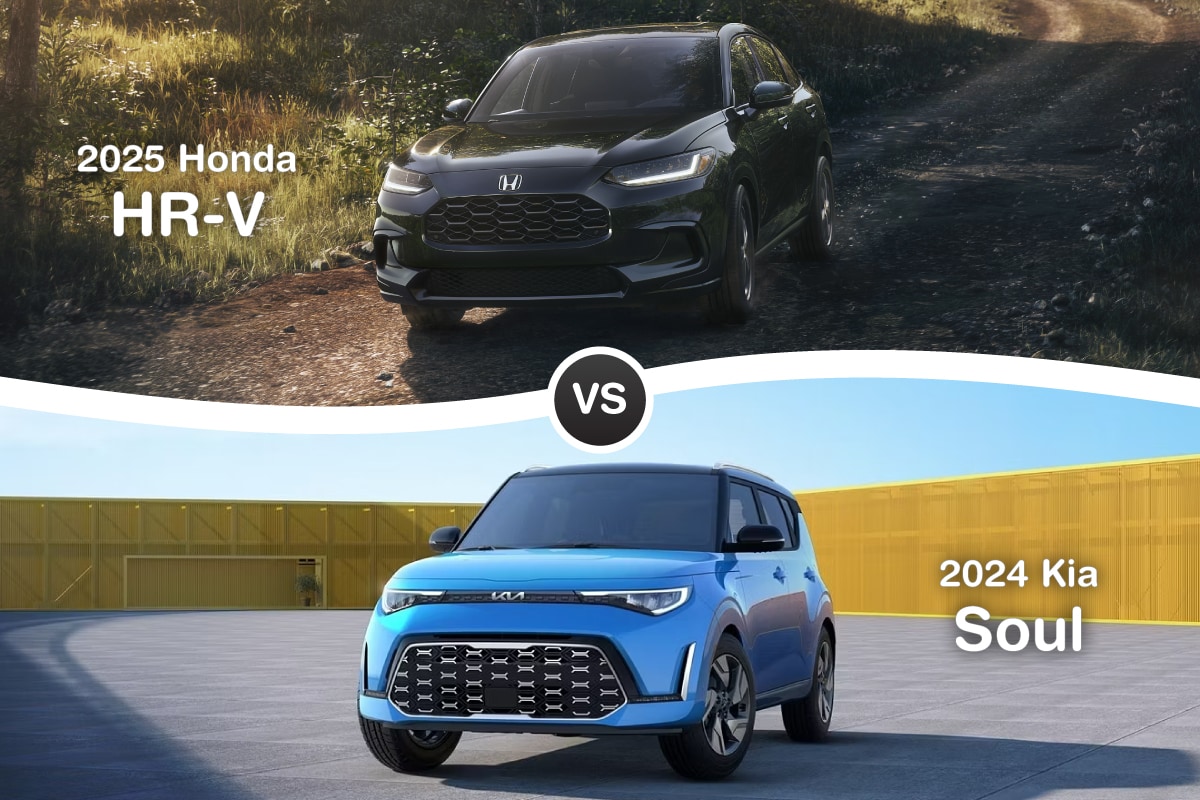
It’s hard to imagine life before subcompact SUVs, but they haven’t always been around. Twenty years ago, if you walked onto a car lot and asked to test drive one, you might be met with a roomful of confused looks.
These days, subcompacts dominate the market. They offer competitive fuel economy and plenty of cargo space, and they’re easy to maneuver on cramped city streets, so it’s easy to see why the trend caught on. Now, we have the opposite problem—just about every major automaker has at least one example, so how are you supposed to pick the best small SUV?
We don’t have time to compare ‘em all, but we do have time for a couple. Here’s how the Honda HR-V stacks up against the Kia Soul.
Powertrains and Performance
Both bold SUVs are available with but a single-engine option:
- 2025 Kia Soul – 2.0-liter four-cylinder with 147 horsepower and 132 pound-feet of torque
- 2025 Honda HR-V – 2.0-liter four-cylinder with 158 horsepower and 138 pound-feet of torque
The HR-V is capable of 26 miles per gallon in the city and 32 on the highway, while the Soul gets 27 in the city and 33 on the open road. So, while the numbers vary slightly, both are effectively neck-and-neck in terms of power and fuel economy. Does that mean they’re evenly matched?
Not quite. The key difference is the drivetrain selection; the Soul can only be optioned with front-wheel drive. Meanwhile, the HR-V has both FWD and AWD available, making it both safer and more capable for folks who like to venture off the tarmac every once in a while.
Passenger and Cargo Space
One of the main differences between these crossovers is their body styles. The designers of the HR-V went for a more classic wagon-like profile, while the Soul sports its trademark boxy silhouette. The exterior shape affects the interior dimensions, but which is the most spacious compact SUV overall?
Here’s a side-by-side breakdown:
|
|
2025 Honda HR-V |
2024 Kia Soul |
|
Head room (front/rear) |
39.4 in / 38.0 in |
39.9 in / 39.5 in |
|
Shoulder room (front/rear) |
56.6 in / 55.2 in |
55.5 in / 54.7 in |
|
Leg room (front/rear) |
41.9 in / 37.7 in |
41.1 in / 38.8 in |
|
Cargo room (behind 2nd row) |
24.5 cu ft |
24.2 cu ft |
Looking at these dimensions, we see that the Soul has more rear legroom and more headroom in both rows, and the HR-V has more front legroom and more horizontal space for rear passengers to stretch out. The Honda also has an edge in the volume of cargo it can carry in the back.
What about when the seats are folded? In their review of the HR-V, Car and Driver noted that they were able to fit 22 suitcases behind the front row thanks to its flat-folding seats, while they were only able to fit 20 in the Soul’s cargo area due to the second row’s inability to fold all the way down.
Put simply, the Soul caters a bit better to taller folks, while the HR-V will likely be the better SUV for families of four or five.

Technology and Comfort
Both SUVs have two infotainment options. The base-level Soul LX comes with an 8.0-inch touchscreen display, while all other trims get 10.25 inches; the HR-V LX and Sport have a 7.0-inch deal, while the upper-level EX-L has a 9.0-inch screen. The Soul wins points for being a bit bigger, but the overall interface isn’t quite as crisp as the HR-V’s, and it’s positioned lower on the dash, which requires drivers to take their eyes off the road for longer.
Whichever one you buy, they come equipped with wireless Apple CarPlay, Android Auto, Bluetooth, and multiple USB ports, and both have available wireless phone charging.
The HR-V and the Soul both have plush, comfortable seating, and the front rows have multiple adjustment settings, but the HR-V boasts more cubby storage and a larger center console.
Safety and Security
HR-V and Soul owners will enjoy a solid selection of driver assistance features through Honda Sensing and Kia Drive Wise, respectively.
Standard features for the HR-V include adaptive cruise control with low-speed follow, collision mitigation braking, forward collision warning, lane keeping assist, lane departure warning, road departure mitigation, traffic jam assist, traffic sign recognition, and auto high beams, and blind spot information system is available as well. It also has an impressive amount of active and passive safety features. The 2025 model has yet to be tested, but the nearly identical 2024 HR-V won a Top Safety Pick+ award from the IIHS.
On the other hand, the Soul’s standard features include forward collision avoidance with pedestrian detection, lane departure warning, lane keeping assist, lane following assist, speed limit assist, and rear occupant warning. Features like blind spot monitoring and lane change assist are only available on the upper trims, and adaptive cruise control is not standard at any level, requiring a significant upcharge. The 2024 Soul won impressive scores from the IIHS, but it received no awards due to its subpar child seat anchors.
It's a close call, but the HR-V stands out as the clear choice for the safest small SUV of the pair.
And the Winner Is…
The Kia Soul is a great example of a compact SUV done right, and some may even prefer it, but the HR-V pulls ahead in safety, comfort, and interior space.
Roper Honda is your go-to stop for a quality subcompact in Joplin. We have some killer special offers on new vehicles right now, and our Buy Your Way program allows you to do all your shopping without even leaving the house. Contact us online or give our sales department a call at (877) 747-0738 to find out how you can score a great deal on a Honda HR-V near Springfield today.